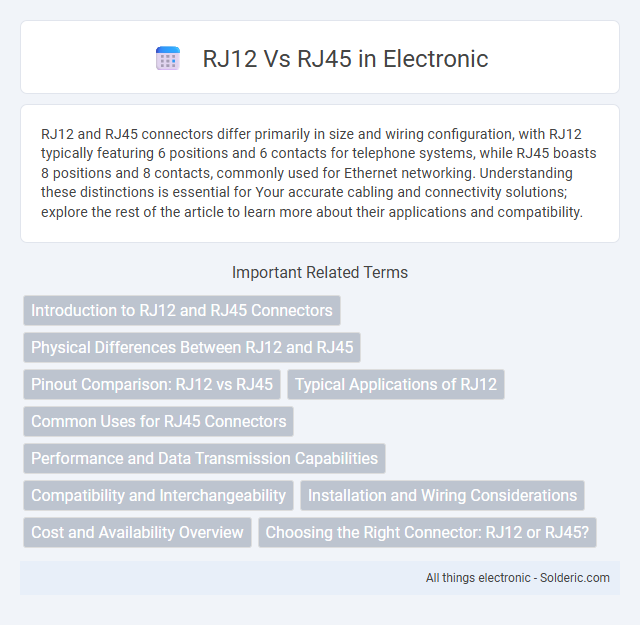RJ12 and RJ45 connectors differ primarily in size and wiring configuration, with RJ12 typically featuring 6 positions and 6 contacts for telephone systems, while RJ45 boasts 8 positions and 8 contacts, commonly used for Ethernet networking. Understanding these distinctions is essential for Your accurate cabling and connectivity solutions; explore the rest of the article to learn more about their applications and compatibility.
Comparison Table
| Feature | RJ12 | RJ45 |
|---|---|---|
| Connector Type | 6P6C (6 positions, 6 contacts) | 8P8C (8 positions, 8 contacts) |
| Common Use | Telephone lines, key telephone systems | Ethernet networking, data communication |
| Cable Type | Flat or round telephone cable | Twisted pair Ethernet cable (Cat5, Cat6, etc.) |
| Pin Configuration | 6 pins, uses all 6 for signal and power | 8 pins, used for data transmission |
| Data Rate Support | Low speed, up to voice/data telephony | High speed, up to 10 Gbps Ethernet |
| Physical Size | Smaller, narrower than RJ45 | Larger, wider connector |
| Compatibility | Not compatible with RJ45 ports | Not compatible with RJ12 ports |
Introduction to RJ12 and RJ45 Connectors
RJ12 and RJ45 connectors are types of registered jacks used primarily in telecommunications and networking. RJ12 connectors feature 6 positions and 6 contacts (6P6C), commonly used for telephone wiring, while RJ45 connectors have 8 positions and 8 contacts (8P8C), designed mainly for Ethernet network cables. Understanding the difference between RJ12 and RJ45 connectors is essential for ensuring your devices and cables are compatible with your communication and networking setups.
Physical Differences Between RJ12 and RJ45
RJ12 connectors feature 6 positions and 6 contacts (6P6C), making them narrower compared to RJ45 connectors, which have 8 positions and 8 contacts (8P8C). The physical size difference means RJ12 plugs fit smaller modular jacks typically used for telephone wiring, while RJ45 plugs are designed for Ethernet networking cables. Understanding the physical distinctions between RJ12 and RJ45 helps you ensure compatibility with your specific communication or networking hardware.
Pinout Comparison: RJ12 vs RJ45
RJ12 connectors feature 6 positions and 6 contacts (6P6C), primarily used for telephone wiring with a pinout that supports up to three telephone lines. RJ45 connectors use 8 positions and 8 contacts (8P8C), commonly deployed in Ethernet networking, with a pinout designed for data transfer using twisted-pair cabling and supporting speeds up to 10 Gbps in Cat6a cables. The pinout difference causes RJ12 to be incompatible with RJ45 sockets, where RJ12 pinouts prioritize voice signals and RJ45 pinouts are optimized for network data transmission.
Typical Applications of RJ12
RJ12 connectors are primarily used in telephone systems and key telephone systems for voice communication, supporting up to six positions and six conductors. They are common in business telephony setups, including PBX systems, and for connecting multiline telephone handsets. RJ12 cables often facilitate communication within office environments where compact, reliable connections are needed for voice signals rather than high-speed data transfer.
Common Uses for RJ45 Connectors
RJ45 connectors are predominantly used in Ethernet networking to connect computers, routers, switches, and other network devices, supporting speeds from 10 Mbps to 10 Gbps. They are widely employed in local area networks (LANs), telecommunications, and structured cabling systems for data transmission. RJ45 connectors facilitate reliable high-speed communication across twisted-pair cables such as Cat5e, Cat6, and Cat7.
Performance and Data Transmission Capabilities
RJ45 connectors support higher data transmission speeds up to 10 Gbps over Cat6a cables, making them ideal for modern Ethernet networks requiring robust performance and reliability. RJ12 connectors are typically limited to lower speeds and telephone line applications, offering data transmission suitable for up to 1 Gbps but not optimized for heavy network traffic. The enhanced shielding and eight-pin design of RJ45 provide superior performance in data-intensive environments compared to the six-pin configuration of RJ12.
Compatibility and Interchangeability
RJ12 connectors feature 6 positions and 6 contacts, primarily designed for telephone systems, while RJ45 connectors have 8 positions and 8 contacts, supporting Ethernet networking protocols. These connectors are not directly interchangeable due to pin configuration differences, leading to potential signal issues if mismatched. You should ensure device compatibility by selecting the correct connector type for your specific telecommunications or networking equipment to avoid connectivity problems.
Installation and Wiring Considerations
RJ12 connectors use 6 positions and 6 contacts (6P6C), suitable for telephone systems with simpler wiring, while RJ45 connectors have 8 positions and 8 contacts (8P8C), supporting more complex network installations like Ethernet. RJ12 wiring follows a standard 6-wire configuration typically used in phone lines, whereas RJ45 utilizes T568A or T568B standards for 8-wire twisted-pair cables to ensure compatibility with networking equipment. Installation of RJ45 requires more precise cable preparation and termination due to the higher number of conductors, affecting performance in data transmission over long distances.
Cost and Availability Overview
RJ12 cables are generally more affordable due to their simpler design and lower demand, making them a cost-effective choice for basic telephony systems. RJ45 connectors, commonly used for Ethernet networks, are widely available and slightly more expensive because of their enhanced capability to support high-speed data transmission. Your decision may hinge on budget constraints and the specific networking requirements, with RJ45 offering greater availability for advanced applications.
Choosing the Right Connector: RJ12 or RJ45?
Selecting the right connector depends on your specific application: RJ12 connectors feature 6 positions and 6 contacts (6P6C), commonly used for telephone wiring, while RJ45 connectors have 8 positions and 8 contacts (8P8C), designed for Ethernet and high-speed data networks. RJ45 supports faster data transfer rates and is suitable for modern networking needs, whereas RJ12 is limited to voice and low-speed data transmission. Understanding the wiring requirements and network infrastructure ensures the correct choice between RJ12 and RJ45 for reliable connectivity.
RJ12 vs RJ45 Infographic

 solderic.com
solderic.com